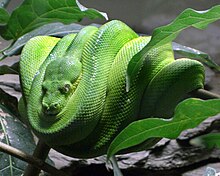Python - Simple English Wikipedia, the free encyclopedia
| Pythonidae | |
|---|---|
 | |
| Indian python, Python molurus | |
| Scientific classification | |
| Kingdom: | |
| Phylum: | |
| Subphylum: | |
| Class: | |
| Order: | |
| Family: | Pythonidae |

Python is the name given to a genus of constricting snakes.[1] Such snakes are not venomous. its family is the Pythonidae. Pythons are more closely related to boas than to any other snake family.
Boulenger (1890) thought this group was a subfamily (Pythoninae) of the family Boidae (boas).[2] However, boas produce live young, while pythons are oviparous: they lay eggs.
Python can be found in Southeast Asia and Africa, and other members of the family are found in New Guinea and Australia, like water pythons, where they live near water, like rivers, swamps, and wetlands. The Australian Olive Python is a fascinating python known for its impres[3]sive [4]size and distinctive appearance.[1] Pythons can range from 3 feet long in species like ball pythons to 29 feet in species like reticulated pythons. Python is one of eight genera in the family. They all have a rather similar life style.
Most members of the family are ambush predators: they stay motionless in a camouflaged position, and then strike suddenly at passing prey. They wrap their body round the prey and squeeze. To kill its prey, the python squeezes it to death,[5] then swallows it whole. Larger pythons can prey on animals as large as a full-grown deer. In Africa, there are pythons that eat gazelles. Most of their prey is much smaller than that. Pythons may take several days or even weeks to fully digest prey. Despite their size, pythons are rarely dangerous to humans.
Python can be up to 900 cm long and weigh up to 90 kg, but males are much smaller and lighter than females. The python can live up to 30 years. The breeding time is between 60 or 70 days. Burmese python snakes are one of the largest snakes to be kept as pets. Due to their large size, they need a large enclosure. For young Pythons, at least 6 feet long, 3 feet wide, and 3 feet tall (1.8×0.9×0.9 meters) enclosure is needed. When they grow up, they’ll need a bigger space. An adult[6] Burmese python snake requires around 12 feet long, 6 feet wide, and 6 feet tall (3.6×1.8×1.8 meters) or even larger enclosure.
Research indicates that all snakes, including pythonids, are children from a venomous father.[7]
Pythons in unusual places
[change | change source]Burmese pythons have become an invasive species in south Florida. The problem is most serious in the Everglades National Park.[8]
In 2014 a pet python killed two children in New Brunswick, Canada.[9]
References
[change | change source]- ↑ Hannover Zoo: Python Archived 2013-02-03 at the Wayback Machine, viewed 2012-12-07
- ↑ McDiarmid R.W; Campbell J.A. & Touré T. 1999. Snake species of the world: a taxonomic and geographic reference. vol. 1, Herpetologists' League. ISBN 1-893777-00-6 (series). ISBN 1-893777-01-4
- ↑ curie, Marie (2024-09-10). "Water Python: Care, Diet & Handling Tips for Exotic Pet Owners". SNAKES WORLD. Retrieved 2024-09-11.
- ↑ curie, Marie (2024-09-06). "Olive Python: Expert Care Tips, Habitat, Diet, & Handling Guide". SNAKES WORLD. Retrieved 2024-09-11.
- ↑ The death is caused by suffocation (asphyxiation): the prey cannot breathe.
- ↑ curie, Marie (2024-08-07). "Albino Burmese Python: Characteristics, Care Sheet, and Fun Facts". SNAKES WORLD. Retrieved 2024-08-23.
- ↑ Bryan G. Fry; et al. (2006). "Early evolution of the venom system in lizards and snakes". Nature. 439 (7076): 584–588. Bibcode:2006Natur.439..584F. doi:10.1038/nature04328. PMID 16292255. S2CID 4386245.
- ↑ "How have invasive pythons impacted Florida ecosystems? | U.S. Geological Survey".
- ↑ "Man charged in python asphyxiation death of boys". The Toronto Star. 31 March 2015.


 French
French Deutsch
Deutsch